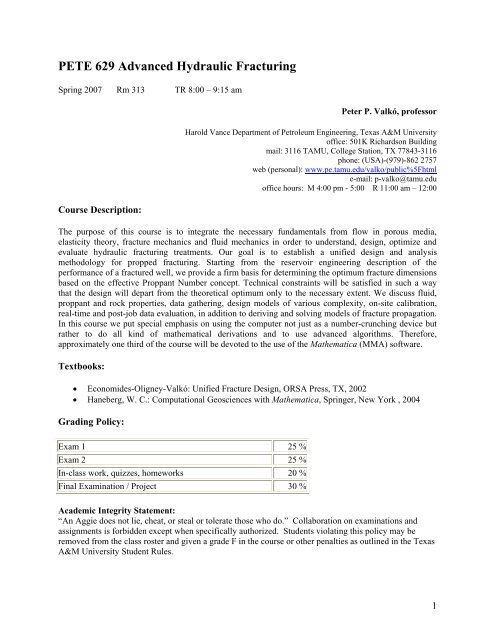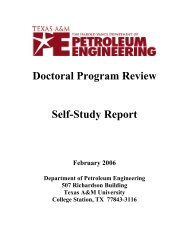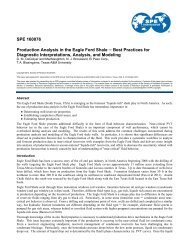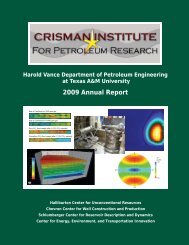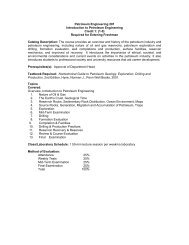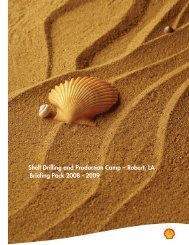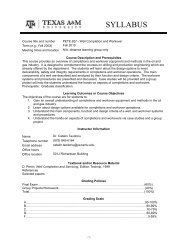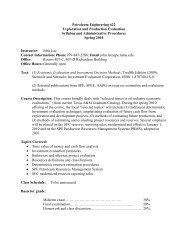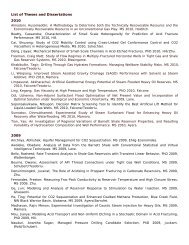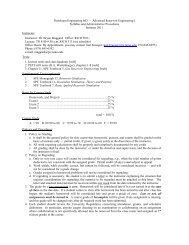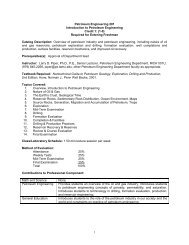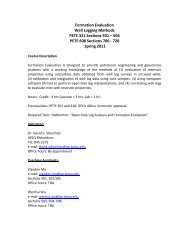PETE 629 Advanced Hydraulic Fracturing - Harold Vance ...
PETE 629 Advanced Hydraulic Fracturing - Harold Vance ...
PETE 629 Advanced Hydraulic Fracturing - Harold Vance ...
Create successful ePaper yourself
Turn your PDF publications into a flip-book with our unique Google optimized e-Paper software.
<strong>PETE</strong> <strong>629</strong> <strong>Advanced</strong> <strong>Hydraulic</strong> <strong>Fracturing</strong><br />
Spring 2007 Rm 313 TR 8:00 – 9:15 am<br />
Peter P. Valkó, professor<br />
<strong>Harold</strong> <strong>Vance</strong> Department of Petroleum Engineering, Texas A&M University<br />
office: 501K Richardson Building<br />
mail: 3116 TAMU, College Station, TX 77843-3116<br />
phone: (USA)-(979)-862 2757<br />
web (personal): www.pe.tamu.edu/valko/public%5Fhtml<br />
e-mail: p-valko@tamu.edu<br />
office hours: M 4:00 pm - 5:00 R 11:00 am – 12:00<br />
Course Description:<br />
The purpose of this course is to integrate the necessary fundamentals from flow in porous media,<br />
elasticity theory, fracture mechanics and fluid mechanics in order to understand, design, optimize and<br />
evaluate hydraulic fracturing treatments. Our goal is to establish a unified design and analysis<br />
methodology for propped fracturing. Starting from the reservoir engineering description of the<br />
performance of a fractured well, we provide a firm basis for determining the optimum fracture dimensions<br />
based on the effective Proppant Number concept. Technical constraints will be satisfied in such a way<br />
that the design will depart from the theoretical optimum only to the necessary extent. We discuss fluid,<br />
proppant and rock properties, data gathering, design models of various complexity, on-site calibration,<br />
real-time and post-job data evaluation, in addition to deriving and solving models of fracture propagation.<br />
In this course we put special emphasis on using the computer not just as a number-crunching device but<br />
rather to do all kind of mathematical derivations and to use advanced algorithms. Therefore,<br />
approximately one third of the course will be devoted to the use of the Mathematica (MMA) software.<br />
Textbooks:<br />
• Economides-Oligney-Valkó: Unified Fracture Design, ORSA Press, TX, 2002<br />
• Haneberg, W. C.: Computational Geosciences with Mathematica, Springer, New York , 2004<br />
Grading Policy:<br />
Exam 1 25 %<br />
Exam 2 25 %<br />
In-class work, quizzes, homeworks 20 %<br />
Final Examination / Project 30 %<br />
Academic Integrity Statement:<br />
“An Aggie does not lie, cheat, or steal or tolerate those who do.” Collaboration on examinations and<br />
assignments is forbidden except when specifically authorized. Students violating this policy may be<br />
removed from the class roster and given a grade F in the course or other penalties as outlined in the Texas<br />
A&M University Student Rules.<br />
1
ADA Policy Statement:<br />
The Americans with Disabilities Act (ADA) is a federal anti-discrimination statute that provides<br />
comprehensive civil rights protection for persons with disabilities. Among other things, this legislation<br />
requires that all students with disabilities be guaranteed a learning environment that provides for<br />
reasonable accommodation of their disabilities. If you believe you have a disability requiring an<br />
accommodation, please contact the Department of Student Life, Services for Students with Disabilities, in<br />
Cain Hall or call 845-1637.<br />
Course Schedule<br />
Week Day Date <strong>Fracturing</strong> Theory<br />
1 T<br />
R<br />
2 T<br />
R<br />
3 T<br />
R<br />
4 T<br />
R<br />
5 T<br />
R<br />
6 T<br />
R<br />
7 T<br />
R<br />
8 T<br />
R<br />
T<br />
Jan.<br />
16<br />
Jan.<br />
18<br />
Jan.<br />
23<br />
Jan.<br />
25<br />
Jan.<br />
30<br />
Feb.<br />
1<br />
Feb.<br />
6<br />
Feb.<br />
8<br />
Feb.<br />
13<br />
Feb.<br />
15<br />
Feb.<br />
20<br />
Feb.<br />
22<br />
Feb.<br />
27<br />
Mar.<br />
1<br />
Mar.<br />
6<br />
Mar.<br />
8<br />
Mar.<br />
13<br />
Orientation, Introduction, History<br />
<strong>Fracturing</strong> Calculations with<br />
Mathematica and other software tools<br />
Introduction to MMA, H_Ch_1<br />
Assigned<br />
Equipment and Materials Special plots, H_Ch_2 HW1<br />
Production forecast, Theoretical<br />
calculations of PI<br />
Optimum Fracture Dimensions<br />
<strong>Hydraulic</strong> <strong>Fracturing</strong> Technology<br />
Conference<br />
Stress State in Formations,<br />
Induced Stresses, Fracture<br />
Initiation and Orientation<br />
Linear Elasticity and Rock<br />
Mechanics Ideal Crack Shapes<br />
Rheology, Fluid Flow in<br />
Fractures<br />
Proppant Transport, Bulk Fluid<br />
Loss Concept<br />
Coupling of Elasticity, Flow and<br />
Mat Balance<br />
Symbolics and equation solving, H_Ch_3<br />
Statistics, Probabilistic simulations,<br />
H_Ch_4-5<br />
HW2<br />
Due<br />
HW1<br />
Interpolation and Regression, H_Ch_6 HW3 HW2<br />
Visualizing and analyzing surfaces,<br />
H_Ch_7 Digital image and signal<br />
processing, H_Ch_8<br />
MMA: Crack shape solutions HW4 HW3<br />
MMA: Solving rheology models<br />
MMA: Derivation of G-function<br />
MMA: Width equations<br />
HW5<br />
HW4<br />
2 D Design MMA: 2D Design HW6 HW5<br />
Modeling Height Containment<br />
Exam 1<br />
MMA: 3D Design<br />
On-Site Injection Test Analysis MMA: Leakoff analysis HW6<br />
Modeling Fracture Propagation: 3<br />
D<br />
MMA: Height<br />
2
R<br />
10 T<br />
R<br />
11 T<br />
R<br />
12 T<br />
R<br />
13 T<br />
R<br />
14 T<br />
R<br />
15 T<br />
R<br />
16 T<br />
17 M<br />
Mar.<br />
15<br />
Mar.<br />
20<br />
Mar.<br />
22<br />
Mar.<br />
27<br />
Mar.<br />
29<br />
Apr.<br />
3<br />
Apr.<br />
5<br />
Apr.<br />
10<br />
Apr.<br />
12<br />
Apr.<br />
17<br />
Apr.<br />
19<br />
Apr.<br />
24<br />
Apr.<br />
26<br />
May.<br />
1<br />
May.<br />
7<br />
Treatment Analysis, Diagnostics MFrac: Design HW7 HW6<br />
Post Job Analysis: Well testing,<br />
Production Analysis<br />
FracPro: Design<br />
Frac & pack, Slopes analysis MMA: Programming 1 HW8 HW7<br />
<strong>Fracturing</strong> horizontal wells MMA: Programming 2<br />
Staging strategies, Perforation<br />
strategies. Near wellbore<br />
tortuosity diagnostics, Proppant<br />
and high-viscosity slug<br />
techniques<br />
Exam 2<br />
Boundary element model of finite<br />
conductivity fracture, pss PI<br />
Transient performance models<br />
Current trends<br />
Project Presentations<br />
Project Presentations<br />
Project Presentations<br />
No class (day redefined to be F)<br />
1-3: pm Final Exam (if not<br />
waived)<br />
MMA: Symbolics Projects HW8<br />
MMA: Numerics<br />
MMA: Visualization<br />
Project<br />
Interim<br />
Report<br />
1<br />
Project<br />
Interim<br />
Report<br />
2<br />
Project<br />
Final<br />
Report<br />
3


